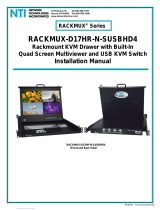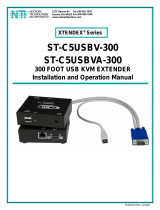
NTI ENVIROMUX SENSOR INSTALLATION
5
If the rope is still giving you problems after you have cleaned it with isopropyl alcohol or if you think the rope needs a good
scrubbing, you can clean it with warm soapy water. You will have to remove the rope from its installed location. It may be helpful
to label the sections of the rope or note their locations before you start for an easier re-installation.
1. Gather Dawn dish soap, a large bucket or plastic bin, warm water, soft-bristled scrub brushes, and clean rags.
2. Add dish soap to the bucket of water, approximately 1 cup of detergent to 1 gallon of warm water. To determine if the
solution is concentrated enough, place your finger and thumb in the water and rub them together. You should feel a
slick/slimy residue. If you do not feel a residue, add more detergent to the water and gently mix to distribute the soap.
3. Submerge a section of the rope in the water. Using a scrub brush or rag, scrub along all sides of the rope with firm
pressure.
4. Remove the section of the rope from the soapy solution and rinse it in a bucket of clean, fresh water.
5. Ensure that there are no oily deposits along the length of the rope. If the rope does not appear clean, submerge it in
water and scrub again, repeating steps (3) to (5).
6. Hang the clean rope up to dry. Try to point the connectors down, so water cannot pool inside the connectors. The drying
process may take 6-8 hours, depending on the room conditions.
7. When the rope is completely dry, reinstall it in its original location.
Contact Sensors
Up to five dry-contact sensors or liquid detection sensors can be connected to the terminals marked “DIGITAL IN”. Sensors with
16-26 AWG connection wires that operate on 5V at 10mA maximum current may be used. A contact resistance of 10k or less
will be interpreted by the E-MINI-LXO as a closed contact.
Examples of Dry-Contact Sensors for the E-MINI-LXO:
NTI # Description NTI # Description
E-EBS Emergency Button E-SDS-PA Smoke Detection Sensor-Power added
E-IMD-P Infrared Motion Sensor w/power E-TDS Tamper Switch
E-M-DCS3 Door Contact Sensor E-DCS-PS2 Plunger-Style Door Contact Sensor
To install the dry-contact sensor(s):
A. Attach the positive lead to a terminal corresponding to a "+" marking on the E-MINI-LXO and the ground lead to the next
terminal to the right that will correspond to a “ “ marking on the E-MINI-LXO. Tighten the set screw above each contact.
Terminal sets are numbered 1-5.
B. Mount the sensors as desired.
Figure 3- Terminal block for dry-contact sensors
Note: The terminal block is removable for easy sensor wire attachment if needed.
Shielded cable must be used to connect to the DIGITAL IN terminals in order to meet CE emission requirements.
Connect the drain wire of the shield to the ground ( ) terminal of the dry contact in addition to the contact return wire.
























